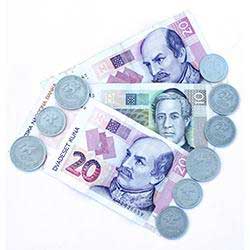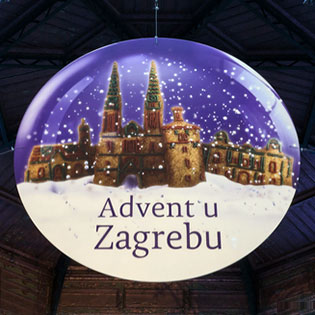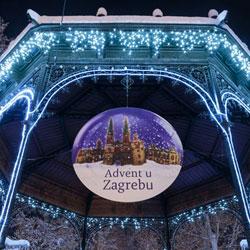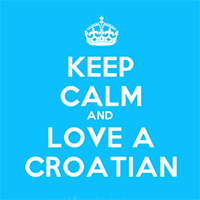The first series of kuna, the monetary unit of the Republic of Croatia, was printed in November 1993 and shortly after, on May 30th 1994, it was introduced as the official currency. You can find out more about kuna and lipa in our previous post.
The obverse of the banknotes feature important politicians and writers and the reverse side depicts famous buildings or a ground plan of a city.
We’ll start our virtual journey through Croatian history and culture with the smallest banknote – ten kuna.
10 kuna banknote
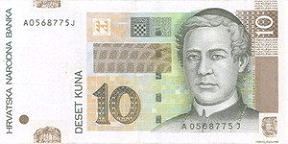
OBVERSE: Juraj Dobrila
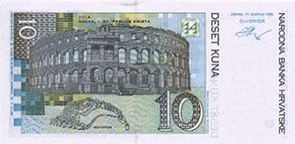
REVERSE: Arena in Pula
Juraj Dobrila was a Croatian bishop and politician and was an important figure of the 19th century. He fought for equality between the Slavic and Italian population of Istria.
The Roman amphitheatre in Pula was constructed during the 1st century A.D. and its original purpose was to be a stage where gladiator fights were held. Nowadays, this top visited sight in Pula is a place for concerts during the warm summer nights.
20 kuna banknote
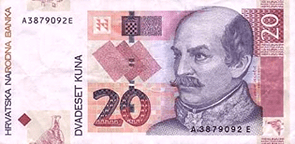
OBVERSE: Josip Jelačić
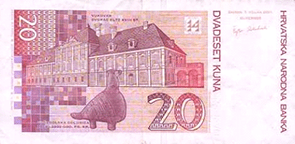
REVERSE: Vučedol dove and the Caste of Count Eltz in Vukovar
Josip Jelačić was a Croatian viceroy ban during the 19th century. He was an ardent fighter against the Hungarian government and dominance. You can find a statue of him riding a horse on the Zagreb Main square. That’s also the most popular meeting point in Zagreb (Nađimo se u devet kod bana! Let’s meet at nine by the viceroy!).
Vučedol dove (Vučedolska golubica) is a ritual ceramic vessel and famous emblem of Vučedol culture, excavated in 1938. Eltz Manor is an elegant baroque building and former mansion of the Eltz family and nowadays a symbol of the town of Vukovar.
50 kuna banknote
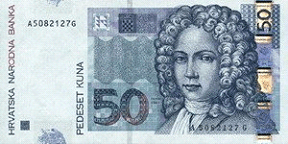
OBVERSE: Ivan Gundulić
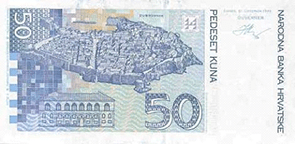
REVERSE: Dubrovnik
Ivan Gundulić was a celebrated baroque poet from the Republic of Dubrovnik. Some of his most famous works are the epic poem Osman and the pastoral play Dubravka. The former glorifies liberty and its verses Oh beautiful, oh precious, oh sweet Liberty (O, lijepa, o, draga, o, slatka slobodo) are traditionally used in the opening ceremony of the Dubrovnik Summer Festival in old city of Dubrovnik.
In the centre of every banknote (next to the recognizable emblem of Croatia) there’s the text of the Croatian national anthem Our beautiful homeland (Lijepa naša).
100 kuna banknote
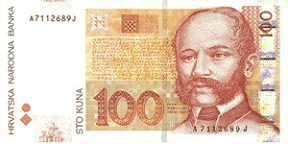
OBVERSE: Ivan Mažuranić
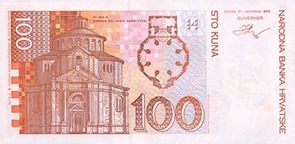
REVERSE: Church of St. Vitus in Rijeka
Ivan Mažuranić was a Croatian poet and politician in the 19th century. He was a former Croatian viceroy and writer of the most popular Croatian epic modern poem Death of Smail aga Cengic.
Church of St. Vitus in Rijeka is a Romanesque church built in 1638 on the site of a medieval church and dedicated to the patron saint of the city Rijeka.
200 kuna banknote
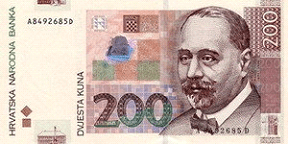
OBVERSE: Stjepan Radić
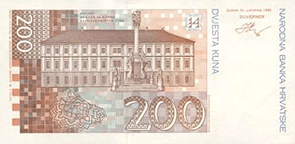
REVERSE: building of the general headquarters in Osijek, 1726
Stjepan Radić was a Croatian politician during the first half of the 20th century. He was a defender of Croatian interest and founder of the Croatian People's Peasant Party, which is active to these days.
The former general headquarters and military command building in Osijek is now the seat of the Rector and the Agricultural Faculty of the University in Osijek. It was erected in the 18th century upon the orders of Prince Eugene of Savoy. In front of the building, there’s a monument of the Holy Trinity which was built in the memory of plague (kuga) victims who perished during the 17th and 18th centuries.
500 kuna banknote
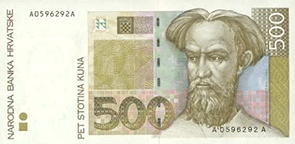
OBVERSE: Marko Marulić
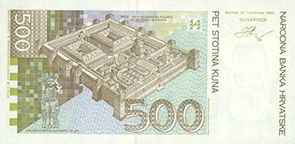
REVERSE: Diocletian's Palace in Split and the figure of a Croatian ruler from XI century
Marko Marulić was a Croatian writer in the 15th century. He is also known as the father of Croatian literature (otac hrvatske književnosti) and one of the most famous citizens of Split. His most known work is a poem called Judita that recounts the Biblical story of Judith and Holofernes. You will find his statue in many cities of Croatia, for instance in front of the Croatian State Archive in Zagreb or, of course, in Split.
Diocletian's Palace (Dioklecijanova palača) is the ancient palace of the Roman Emperor Diocletian and one of the greatest attractions in Split. It is one of the best-preserved monuments of the Roman architecture in the world – built between the late 3rd and the early 4th century A.D. and added to UNESCO's World Heritage List in 1979. Interestingly, even today there are many inhabited houses and apartments inside the Palace walls.
Croatian hip-hop band Tram 11 mentions important people depicted on Croatian banknotes in their famous song Croatian nobles (Hrvatski velikani). Try to understand which banknotes the band mentions! The lyrics might help you!
1000 kuna banknote
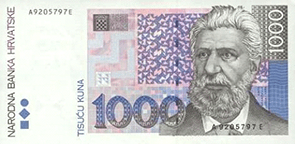
OBVERSE: Ante Starčević
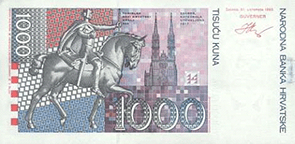
REVERSE: monument to King Tomislav and the Zagreb cathedral
Ante Starčević, considered the father of the nation, was a politician who founded the Pure Party of Rights in the 19th century.
If you arrive in Zagreb by train, the first thing you’ll see when you exit the Central railway station is a beautiful statue of the Croatian king Tomislav, who reigned in the 10th century. On the banknote, you can also see the Zagreb Cathedral (Zagrebačka katedrala) which is the largest Croatian sacral building. It was constructed in 1102, later destroyed by Tatars and then restored in the late 13th century. After the earthquake in 1880, architect Hermann Bollé gave it a new neo-Gothic appearance, which it has to this day.
Interestingly, but sadly, amongst important figures of the Croatian history and culture listed on the banknotes, there’s not a single woman to be found. Hopefully, this will change in the future.
Do you know the following useful words and phrases?
To test your Croatian language skills, watch this video on Croatian banknotes.

